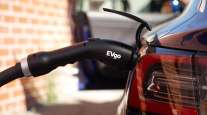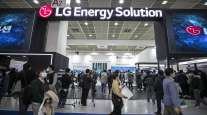Staff Reporter
Alaskans Help State Officials Prepare for EV Charging

[Stay on top of transportation news: Get TTNews in your inbox.]
The Alaska Energy Authority is working to overcome public perception barriers of cold climate performance, driving range anxiety and high electricity demand charges in its electric vehicle infrastructure push.
Public comments have helped AEA better understand Alaskans’ priorities and been incorporated into the state’s evolving plans to spend some $50 million in federal funds over the next five years to build a statewide EV fast-charging network as well as urban and rural community-based charging sites.
AEA was designated as the lead state agency (in collaboration with the Department of Transportation and Public Facilities) because it had experience since 2018 deploying EV charging stations using money from the Volkswagen Diesel Emissions Environmental Mitigation Trust.

Thayer
AEA Executive Director Curtis Thayer told Transport Topics his agency is developing a memorandum of understanding with DOT&PF to define roles in the federal EV infrastructure program, while working together to ensure Alaska conforms with federal guidelines.
Thayer said public input, which mostly supports the state’s key EV concepts, is a key component of Alaska’s EV infrastructure plan that “is intended to be a living document,” modified as needed.
“The plan will be reviewed and updated annually and may change based on feedback received. AEA will continue its outreach efforts to educate Alaskans about EVs and the plan, and welcome opportunities for presentations throughout the state,” Thayer said.
One concern voiced by the public has been about EV performance in frigid Alaska. In May, AEA and Railbelt utilities announced plans to spend over $200 million to upgrade transmission lines to reduce line loss, increase capacity and stabilize the grid for electric battery energy storage systems.

An AEA-funded electric vehicle fast charger at the Jack River Inn in Cantwell, Alaska. (Alaska Energy Authority)
Along the Railbelt corridor, a 700-mile stretch where 70% of the state’s population is interconnected to the electricity grid, average low temperatures in the winter range between minus 20℉ and 5℉, with much colder temperatures occurring frequently throughout the season.
“These cold temperatures can cause a range decrease of up to 50% for EVs, which will contribute to range anxiety. Colder temperatures can also increase the time required to charge the battery,” Thayer explained.
He pointed to the state’s only electric school bus operated by Tok Transportation, located in the interior that experiences some of Alaska’s coldest winter temperatures.
In the milder seasons, the bus uses from 1.4 to 1.7 kilowatts per mile, but that efficiency rate changes to 3.46 kilowatts per mile when the temperate drops to minus 38 degrees, he said. Extra energy costs are spent heating the bus interior at least 45 degrees. To increase efficiency, the battery is insulated and the engine is covered.

Host Mike Freeze gets Jason Gies, Navistar's VP of eMobility, to spill the tea on everything from how fleets are charging now to how far policymakers are willing to go to up the public electric truck charging game. Tune in above or by going to RoadSigns.TTNews.com.
AEA will develop procurement specifications for EV charging stations using technical information from vehicle manufacturers about operating temperature performance.
“Many vehicles can still travel 50 to 100 miles with no problem in the winter,” Thayer said. “Educating the public on EV performance in cold climates will also help alleviate this barrier.”
Spacing charging stations 50 miles apart should mitigate lower EV range performance in colder weather and eliminate the range anxiety barrier, he added.
Although it experiences “significant freight movement,” Alaska’s designated alternative fuel corridor covers the Glenn Highway (part of Alaska Route 1) and George Parks Highway (connecting Anchorage and Fairbanks), he noted.
“AEA cannot control the size and range of batteries on the vehicles, but it can facilitate where the infrastructure will go,” Thayer said, relating that stations also are to be located no more than 1 mile from the highway. “This will help provide EVs with better access to long-distance charging support.”
Want more news? Listen to today's daily briefing above or go here for more info
To ease concerns about high-demand charges and support development of DC fast-charging stations, the state Regulatory Commission released an order enabling Railbelt utilities to create a 10-year interim EV charging tariff to reduce the cost impacts of peak-load demand at charging stations. It also authorized charging stations to resell electricity without being classified as publicly regulated electric utilities.
Thanks to public suggestions, Alaska’s EV infrastructure plan includes charging stations with pull-through areas for vehicles towing trailers.
Also, AEA now has a list of interested parties (that submitted their business information and coordinates) for charging stations that will help the state during the competitive procurement phase in priority areas.
“During phase two, AEA will shift focus to the Alaska Highway System and the Alaska Marine Highway System. However, the focus of the plan is on passenger — or light-duty — vehicle charging,” Thayer said. “AEA continues to monitor information and guidance provided by the Federal Highway Administration and the Joint Office of Energy and Transportation on medium- and heavy-duty vehicles and will update the plan annually as additional guidance is provided.”




